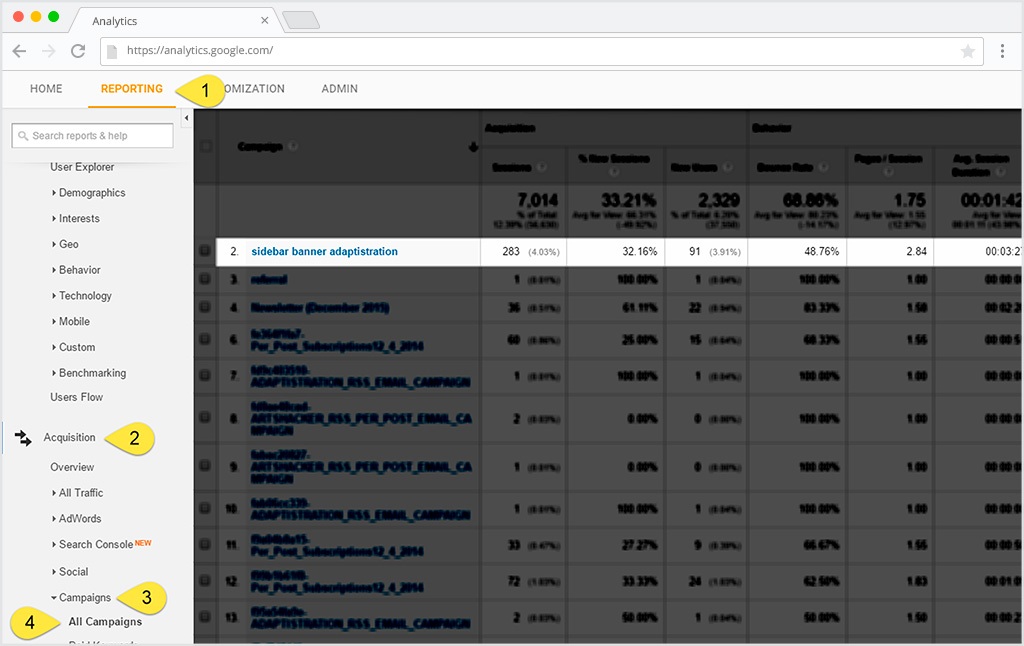Once you’ve completed must-have configuration and settings modifications to your Google Analytics (GA) account, such as activating demographics reporting and search tracking then filtering out your own visits, it’s time to dive into some of the more dynamic skills, such as modifying the default Session and Campaign lengths.
Out of the box, GA assigns default session and campaign lengths (source).
[box]
By default, sessions end after 30 minutes of inactivity and campaigns end after six months. You can change the settings so sessions and campaigns end after the specified amount of time has passed.
Campaign timeout cannot be greater than two years. Sessions cannot be less than one minute or greater than four hours.
[/box]
Google provides some basic considerations on how to determine a reasonable length for your timeout threshold.
[box]
The length of a session and campaign depends on your site and business. Here are a few ideas to get you started thinking about session and campaign timeouts:
- If your site automatically signs a user out after being inactive for a certain amount of time, set the session timeout to match that length of time.
- Lengthen the session time if you have a lot of content and expect users to take a long time engaging with that content. Conversely, shorten the session time if the site has a small amount of content.
- Set the campaign timeout handling to the same amount of time the campaign is going to run or expected to be relevant. Clicks to a social media micro-campaign might not be relevant for more than a few days after launch.
[/box]
The first suggestion is a no-fail solution, so if your primary website or ticketing website provider logged in user functionality and you aren’t sure when/if you have an automatic logout threshold, ask your provider.
The third suggestion is equally apt; if you’re running a Facebook ad campaign for one week, then set the campaign timeout to match.
The second suggestion is a bit trickier. If all of this is new to you, the tendency is to set the threshold much higher than you need because you want/hope users spend time on your site engaging with your content.
But if your organization is event based, sells tickets, and provides at least a few events per month you can rest assured that quite a few site visitors are going to engage with your site for only as long as it takes to find an event and purchase a ticket.
If your site is geared more toward engagement without any clear e-commerce oriented goals, you can expect session lengths to be higher.
Editing Session and Campaign Length
This part is super simple; from your Admin dashboard, navigate to Property > Tracking Info > Session Settings and adjust the lengths accordingly:

Session and Campaign Lengths Should Be Fluid
Unlike other GA settings, these shouldn’t necessarily be fire-and-forget; for instance, campaign lengths are likely going to change with each new advertising campaign and should match the duration of that marketing campaign.
When it comes to sessions, here are some examples for helping figure out when to raise or lower timeout lengths.
- Example 1, season announcement: when launching your new season, you’ll probably want users to spend more time than normal combing through all of the new content related to all of your awesome event offerings (the answer we’re looking for there is “yes”). If your session timeout setting is usually 10 min, then you’ll want to crank that up accordingly in order to accurately measure session lengths.
- Example 2, last minute ticket blow-out. It happens to the best of us but your upcoming show simply isn’t selling all that great and you decide to launch a 12-hour sale to help unload ticket inventory along with a handy one-click ticket purchase. In this scenario, you’ll want to lower the session timeout setting to accurately measure those quick purchase turnarounds.
Why Session Length Matters
Open up your GA account and inside the Reporting dashboard, navigate to Acquisition > Campaigns > All Campaigns.
In this example from ArtsHacker’s metrics, you can see that one of the stronger campaigns is “sidebar banner adaptistration.” Perhaps unsurprisingly, this is a banner ad located at adaptistration.com, my blog on orchestra management. The take-away here is that particular campaign is a worthwhile effort.
If you reconfigure the view by one of the Acquisition or Behavior columns as opposed to the default Campaign view, you can begin to discover additional valuable campaign data that will help you determine if you’re generating the type of engagement you’re hoping for via each type of campaign.
In this example, the average session was set to 10 minutes but if it were lower, say two minutes, GA would end up reporting very different results. That doesn’t mean the lower value is “wrong” inasmuch as not providing the data needed to determine the appropriate value of that traffic generation campaign.
Tip: GA won’t report metrics retroactively, meaning, if you edit the session length then immediately go to the campaign report admin panel and refresh the page, the data values will remain unchanged.
If you want to learn more about how GA defines and measures sessions, which is easily one of the most misunderstood metrics inside GA, watch Unit 3, Lesson 2: Processing hits into sessions & users at GA Academy.

